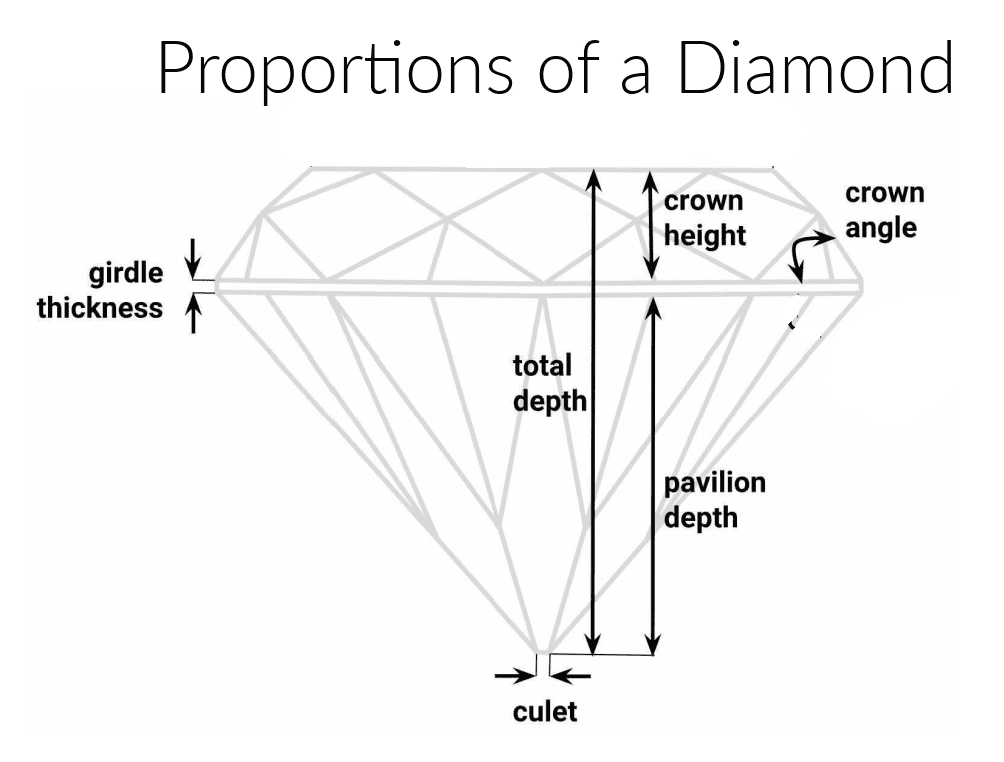What is a Diamond Culet?
The culet of a diamond is the small facet at the bottom of a diamond's pavilion, or the pointy end opposite the top surface, which is known as the table. It's essentially the tip of a diamond when viewed from the side.
Purpose of the Culet: The purpose of the culet is to prevent damage to the diamond, especially for those diamonds with a sharp point at the end. This point can be quite delicate and can chip or break off easily.
Impact on Diamond's Appearance: In terms of appearance, if a diamond's culet is too large, it can be visible through the table of the diamond, appearing as a small, extra facet that looks like a hole in the center of the diamond. On the other hand, if the culet is too small or absent, the risk of chipping could be increased.
Ideal Culet Size: The size of a diamond's culet is usually described using terms such as "None", "Very Small", "Small", "Medium", "Large", "Very Large", and "Extremely Large". For optimal balance between safety and appearance, a "Small" or "Very Small" culet is often preferred.
Think of diamond culet as dessert. You don’t need it to complete the diamond extravaganza. And when you do have it, you shouldn’t have too much. But in the right size, it is the cherry on top.
Or bottom I should say. By definition, ‘culet’ means two things—it means the tiny point at the bottom of the diamond (yes, that sharp, pointy place where the pavilion facets meet) and it means the extra facet that is sometimes added by slicing off the bottom tip of a brilliant cut diamond. You got that right: the culet facet, simply called ‘culet’ on grading reports, is formed when a diamond cutter gasp removes—that’s right, removes, the sharp point at the bottom of the diamond, creating a tiny flat space. Breathe. Find your happy place. No, that cut will not be visible from outer space. Your diamond will be okay.

Now in grading reports, culet grade means culet size. GIA culet grades are: None, Very Small, Small, Medium, Large, Very Large. A culet grade of ‘none’ means that the diamond doesn’t have a culet facet. A diamond without a culet facet will have 57 facets, while a diamond with a culet facet will have 58.
At this point, you’re probably wondering: sooo what are the pros and cons? I mean, why on earth would you cut off a piece of your precious diamond if there isn’t a goshdarn good reason for it? Cause the tip of the diamond can break, that’s why. When the bottom of the diamond is pointed, the point is so thin that it chips easily. Yep, diamonds, despite their hard rep, aren’t the touch guys they pretend to be. Shove one in too hard to your engagement ring setting and it’s welcome to the hard knock life, cause that tip’s gonna fracture, breaking the tip (and your heart). Besides, when the diamond tip chips, it’ll form nasty white fractures that cloud the stone. This reduces diamond clarity. Not so brilliant right? Cue culet facet. Slicing off the diamond tip prevents this nightmare from happening. And no worries, the culet facet is way too small to affect your diamond’s carat size.
So what does this mean for you, the diamond buyer extraordinaire? If you get a diamond with a pointed culet, your jeweler will have to be extra careful setting that diamond (not that they shouldn’t be careful anyway). If the diamond’s already set in a ring, you don’t need to worry about the culet getting chipped, since the setting should protect it from future boo-boos. But you should check that that the culet isn't already chipped. Some jewelers chip their diamonds while setting them and don't even notice!
When you’re buying a diamond with a culet, make sure you buy a diamond with a small culet or even a very small culet (basically the opposite size of how your girl wants that bling). Cause that’s what it takes to get an excellent cut grade. A slightly large or extremely large culet will be visible to the naked eye. This means you’ll be able to see the diamond's culet through the diamond table as a black or white dot. This is ugly and causes light leakage, meaning you won't have a brilliant diamond. And no, do not try to convince your partner she’s getting a ‘snowflake’ diamond. Cause she's way smarter than that. At least we hope so.
Knowing you (I mean, I don’t but whatever), you’ll want a diamond that is sparkling gleaming perfection (cause who doesn’t). Knowing her (again just guessing here, but not really), she’ll want dessert. So, it might be a good idea to get that diamond with a culet facet if you’re buying a loose diamond. Culet=no snowflake diamond. Got it?
But hey, at the end of the day, it’s your diamond. Culet or no culet? No guilt, no judgment. Both work, whichever way you slice it.

